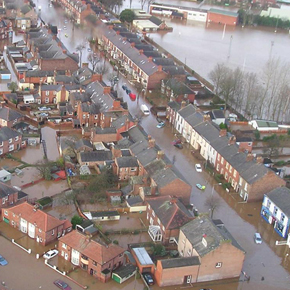
What can we learn from 2015’s devastating floods?
Late last year in the North of England areas of Cumbria were devastated by some of the heaviest rainfall and worst flooding Britain has seen in decades.
Thousands of homes to be left without power and damaged by the flooding, emergency services were overwhelmed and there were several fatalities.
This is not the first time that the country has been ravaged by floods, which have had an enormous and devastating impact on local communities.
ESS, a UK-based environmental waste treatment and recycling firm, looks into how this has happened, and asks what can we learn from events like these that are becoming a regular part of UK weather?
What has happened?
Storm Desmond has battered the UK with rough weather, ravaging the north of England with high winds and heavy rain which is still affecting homes, businesses and local communities.
Severe weather warning for rain has been issued. Stay #WeatherAware at https://t.co/LohpJi9n9A pic.twitter.com/I6ZpcVAmy1
— Met Office (@metoffice) December 6, 2015
The storm has resulted in widespread flooding in a number of local areas. In Honister, in the Lake District, a record breaking 341.4mm of rain fell, cutting transport links and flooding over 3,500 homes.
What was the impact and fallout?
Tens of thousands of people left without power and thousands with flooded homes and businesses are just part of Storm Desmond’s impact in the north. The cost of the recent flooding is currently unknown, however George Osborne recently announced a £50m flood fund to cover the costs as a result of the damage left in the wake of the storm.
A report put to parliament in 2014 put the average annual cost of flooding damage across the UK to £1.1bn.
Whilst there hasn’t been any indication yet on the wider costs of the flooding in Cumbria, it seems like the impact, damage and widespread effects aren’t improving; therefore it’s reasonable to say that this figure will be consistent for this year’s flooding.
What can we learn & what are the next steps?
“If the government is serious about infrastructure, then flood defences should be a greater priority than HS2 or another airport runway” – The Guardian (07/12)
It goes without saying that current strategies, plans and defences need to be improved; events such as Storm Desmond are not one-off and unexpected.
The same report put to parliament also mentions how increasing amounts of money spent on flood defences won’t be wasted, and can help offset the cost of damages by reducing the impact of flooding.
The two statements coming out of the impact of the flooding are calls for an increase in funding for flood defence costs and a continued approach on tackling climate change; although the Met Office has stated that the most recent flooding cannot be confirmed as being linked to this.
Tom Burke, chairman of environmental group E3G, suggests that the current spend alone isn’t enough. On his own website, he commented: “Each time millions of pounds were spent improving flood defences in the region. Each time the defences were overwhelmed by the next ‘unprecedented’ event.
The question the government really needs to answer is why have we had so many unprecedented events in so short a space of time. How many times does it take to set a precedent?”
It appears as if these plans are already being suggested to government, with MP Elizabeth Truss recently addressing the House of Commons on plans for further investment in flood defences.
In her statement she stated: “Since 2009 we have invested £45million in new defences in Cumbria. But we will need to learn lessons and reflect on what we can learn from this extreme weather event.
We are investing £2.3bn in 1500 schemes throughout the country that will better protect 300,000 homes and the Spending Review has also confirmed that we’re protecting flood maintenance spending throughout this Parliament as well as capital spending.”
Will this be enough?
The 2014 report to Parliament suggests that the cost of flooding as a result of damage is only likely to increase enormously in the long term; the report suggests a rise to as much as £27bn per year by 2080 if action isn’t taken.
One thing that has been made clear by recent events is that what is currently in place needs improvement. More investment from local government and more funding from central government will allow this to happen.
Whilst the short-term costs of flood defences will need to see a significant increase; the long-term effects will ensure not only lower costs of damages but less risk to homes, businesses and local communities.
Latest news

28th April 2025
Nuaire first UK ventilation manufacturer to use low carbon-emissions recycled & renewably produced steel
Nuaire has announced that its Magnelis® steel based ventilations systems are now being made from XCarb® recycled and renewably produced steel.
Posted in Air Conditioning, Articles, Building Industry News, Building Products & Structures, Building Services, Building Systems, Heating, Ventilation and Air Conditioning - HVAC, Restoration & Refurbishment, Retrofit & Renovation, Steel and Structural Frames, Sustainability & Energy Efficiency, Waste Management & Recycling
28th April 2025
Renderplas: Builders avoid costly remedial work with PVCu render beads
A pioneer of PVCu render beads, Renderplas is helping the construction industry avoid the costly remedial work associated with rusting steel designs…
Posted in Articles, Building Industry News, Building Products & Structures, Building Services, Building Systems, Facades, Posts, Render, Restoration & Refurbishment, Retrofit & Renovation, Sustainability & Energy Efficiency, Walls
28th April 2025
How Celotex’s Technical Team adds value through expert insulation support
From U-value calculations to real-world installation support, Celotex’s technical team helps construction professionals specify and install insulation with confidence…
Posted in Articles, Building Industry News, Building Products & Structures, Building Services, Insulation, Research & Materials Testing, Restoration & Refurbishment, Retrofit & Renovation, Sustainability & Energy Efficiency, Walls
28th April 2025
Ideal Heating Commercial takes extra care with the heat network at Huddersfield specialist housing development
Ideal Heating Commercial POD Heat Interface Units (HIUs) and Evomax 2 condensing boilers have been installed into Ash View Extra Care in Huddersfield.
Posted in Articles, Building Industry News, Building Products & Structures, Building Services, Case Studies, Facility Management & Building Services, Heating Systems, Controls and Management, Heating, Ventilation and Air Conditioning - HVAC, Pipes & Fittings, Plumbing, Restoration & Refurbishment, Retrofit & Renovation
 Sign up:
Sign up: